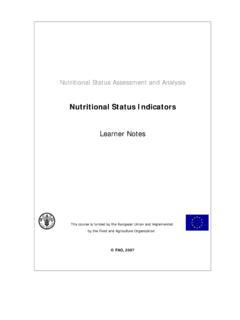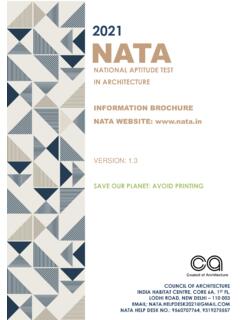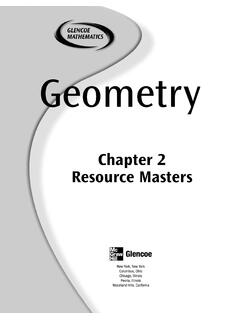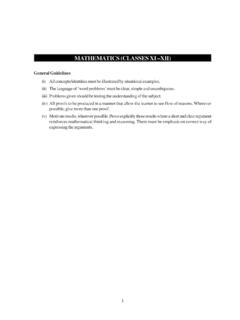Transcription of Mathematics for Primary School Teachers
1 Mathematics for Primary School Teachers Saide, with the Wits School of Education, University of the Witwatersrand Permission is granted under a Creative Commons Attribution licence to replicate, copy, distribute, transmit, or adapt this work freely provided that attribution is provided as illustrated in the citation below. To view a copy of this licence visit or send a letter to Creative Commons, 559 Nathan Abbott Way, Stanford, California, 94305, USA. Citation Sapire, I. (2010). Mathematics for Primary School Teachers . Saide and the Wits School of Education, University of the Witwatersrand, Johannesburg. ISBN: 978-0-9869837-5-7 School of Education, University of the Witwatersrand Tel +27 11 717 3001 23 St Andrew s Road Parktown 2193 Johannesburg South Africa Saide Tel +27 11 4032813 E-mail: P O Box 31822 Braamfontein 2017 Johannesburg South Africa Mathematics FOR Primary School Teachers _____ Contents About the course Mathematics for Primary School Teachers .
2 1 Unit 1: Space and Shape .. 5 Introduction .. 5 The raw material of geometric shapes .. 5 Plane figures .. 11 Polygons and other plane figures .. 22 Space figures .. 32 Pattern work and 42 Unit summary ..51 Assessment .. 52 Unit 2: Numeration .. 53 Introduction .. 53 Multi-base .. 62 Developing number concept .. 71 Number systems we use at School .. 77 reasoning , algebra and number patterns .. 84 Unit summary ..91 Assessment .. 92 Unit 3: Operations .. 93 Introduction .. 93 Background and algorithms for addition and subtraction .. 94 Background and algorithms for multiplication and division .. 101 Multiples, factors and primes: divisibility rules .. 108 Problem-solving, word problems and order of operations .. 117 Unit summary .. 123 Assessment .. 124 Unit 4: Fractions .. 125 Introduction .. 125 Fractions and wholes: introductory concepts and activities.
3 126 Further activities in the teaching of fractions .. 135 Equivalent fractions and comparison of fractions .. 144 Categories of the whole a review of concepts and apparatus .. 153 Apparatus .. 156 Rational numbers .. 164 Unit summary .. 174 Assessment .. 175 Unit 5: Statistics .. 176 Introduction .. 176 Random numbers, population and sample .. 178 Graphical forms of data representation .. 181 Measures of central tendency .. 189 Misleading statistics .. 192 Statistics in the classroom .. 194 Unit summary .. 196 Assessment .. 197 Unit 6: Size and Measurement .. 198 Introduction .. 198 Introduction to concepts and relevant ideas .. 198 Conservation of size some practical exercises .. 204 Unit summary .. 210 Assessment .. 211 Mathematics FOR Primary School Teachers 1 About the course Mathematics for Primary School Teachers Mathematics for Primary School Teachers has been digitally published by Saide, with the Wits School of Education.
4 It is a revised version of a course originally written for the Bureau for In-service Teacher Development (Bited) at the then Johannesburg College of Education (now Wits School of Education). The course is for Primary School Teachers (Foundation and Intermediate Phase) and consists of six content units on the topics of geometry, numeration, operations, fractions, statistics and measurement. Though they do not cover the entire curriculum, the six units cover content from all five Mathematics content areas represented in the curriculum. Unit 1 Space and Shape This unit presents an analytical approach to the study of shapes, including the make-up of shapes, commonalities and differences between shapes and a notation for the naming of shapes. On completion of the unit students should be able to: Identify and describe fundamental properties of shapes. Differentiate between and illustrate two dimensional (2-D) and three dimensional (3-D) shapes.
5 Categorize and compare two dimensional (2-D) and three dimensional (3-D) shapes. Describe and design patterns using tessellations and transformations. Unit 2 Numeration This unit is designed to give insight into a few specially chosen ancient numeration systems. After the presentation of historic numeration systems, there is an in-depth look at the Hindu-Arabic numeration system, still in use today, with its base ten and place value. On completion of the unit students should be able to: Record numbers using a range of ancient numeration systems. Explain the similarities and differences between the numeration system that we use and those used in ancient times. INTRODUCTION 2 Demonstrate the value of multi-base counting systems for Teachers of the base ten numeration system in use today. Discuss the use of place value in the development of number concept.
6 Demonstrate an understanding of number systems that make up real numbers. Apply inductive reasoning to develop generalisations about number patterns and algebraic thinking. Unit 3 Operations In this unit, the four operations addition, subtraction, multiplication and division are discussed. Each operation is first introduced as a concept, and then the different algorithms that can be used to perform the operations with ever-increasing efficiency, are given and explained. Divisibility rules, multiples, factors and primes and topics related to operations are also included in this unit. On completion of the unit students should be able to: Explain and use the algorithms for addition, subtraction, multiplication and division. Demonstrate and illustrate the use of various apparatus for conceptual development of the algorithms for addition, subtraction, multiplication and division.
7 Define and identify multiples and factors of numbers. Explain and use the divisibility rules for 2, 3, 4, 5, 6, 8 and 9. Discuss the role of problem-solving in the teaching of operations in the Primary School . Apply the correct order of operations to a string of numbers where multiple operations are present. Unit 4 Fractions Since fractions are the numerals (symbols) for a group of numbers, the fraction concept is a part of number concept. Fractions can be used to express all rational numbers. In this unit, it is proposed that learners need to be exposed to a range of activities and conceptual teaching on fractions as parts of wholes, ratios, decimals and percentages in order to fully develop their understanding of multiplicative reasoning and rational numbers. On completion of the unit students should be able to: Differentiate between continuous and discontinuous wholes.
8 Demonstrate and explain the use of concrete wholes in the establishment of the fraction concept in young learners. Mathematics FOR Primary School Teachers 3 Illustrate and use language patterns in conjunction with concrete activities to extend the fraction concept of learners from unit fractions to general fractions. Identify improper fractions and be able to convert from proper to improper fractions and vice versa. Determine the rules for calculating equivalent fractions which are based on the equivalence of certain rational numbers. Compare different fractions to demonstrate an understanding of the relative sizes of different rational numbers. Describe the differences between the different forms that rational numbers can take on. Unit 5 Statistics In this very short introductory unit, the most important statistical terminology is introduced, information on statistical representations and interpretation of data is given and measures of central tendency are discussed.
9 On completion of the unit students should be able to: Define and cite examples of key statistical concepts used in Primary schools. Identify graphical forms of data representation. Differentiate between different measures of central tendency. Explain and cite examples of how statistics can be used in misleading ways. Unit 6 Size and Measurement In the first section of this unit the conceptual groundwork needed for the topic of measurement is presented. The second part of the unit investigates some of the conservation tests for measurement concepts. These tests enable the teacher to establish whether or not a learner has understood a certain measurement concept. On completion of the unit students should be able to: Explain and cite examples of general measurement concepts as they may be used in the Primary School to lay a foundation for measurement and calculations with measurements in later years.
10 Apply the conservation tests of Piaget to establish a learner s understanding of length, mass, area, volume and capacity. INTRODUCTION 4 Mathematics FOR Primary School Teachers 5 Unit 1: Space and Shape Introduction In this unit we will look at shapes analytically. We will look carefully at what makes up shapes, and what makes one shape the same as or different from another, and we will set up a notation for the naming of shapes according to this. There are many people who are unfamiliar with this field of Mathematics . They sometimes see it as inaccessible and impossible to master. If you are one of these people (to whatever degree) this course hopes to give you a fresh look at shapes, their characteristics and components, where we find them in our everyday lives, and how the study of shapes can be both useful and interesting for everyone. We will break things down and rebuild them, we will analyse them and make patterns with them.







